From France: the RTM Midway.
C'e Manufique!

What is it about Rotomod?
Not only did they make kayaks for the old OK, but developed some of their own. Designs which represent the very best plastic has to offer.
While other manufacturers were going slower, wider and clunkier (all in an attempt to create new customers), RTM was going faster, narrower and much, much more useful and seaworthy.
And as others companies were dropping great designs, RTM was happy to pick em up. Like me, they knew quality and performance.
RTM was the manufacturer of several of the Ocean Kayak designs, including the Scramblers and the great Scupper Pro. After OK decided to go dumpster diving with WS and dropped good performers like the Pro, Cabo and Drifter in favor of hi-primary bargettes, RTM bought the rights and kept the molds to at least the Pro.
And when the Midway of England was about to go the same route, RTM bought em out and kept the design. And as they did
with the Pro/Tempo, they tweaked the design and improved the fittings. As before, they did a wonderful job.
Today we are here to discuss what is another Pro killer, joining the incredible Disco - depending on your weight. The RTM Midway.
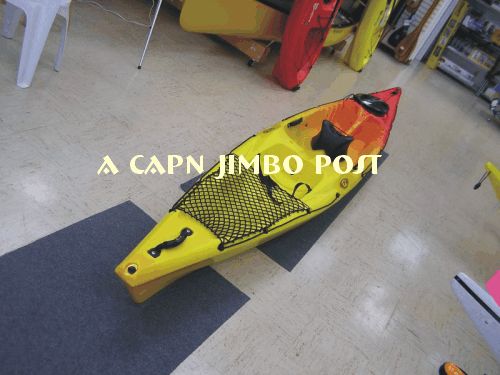
Now I must be honest. The Midway is no Disco (an original RTM design), but its a lean, mean fishin machine.
But first the specs. RTM claims 14'9" x 25.5" x 50 lbs. I got 14'6" x 26" x 60lb (per scale). The boys on duty said it listed at, gulp, $899.
Is is worth it?
First let's look at the layout:

A nice solid entry, full (high prismatic coefficient) and buoyant. Only modest rocker

Here's a side view of the bow. Only a modest overhang, this design depends on volume for buoyancy. But it's got it.
Note the super solid, large stainless tow ring, and the usual chunky and comfy RTM handles. Nice.
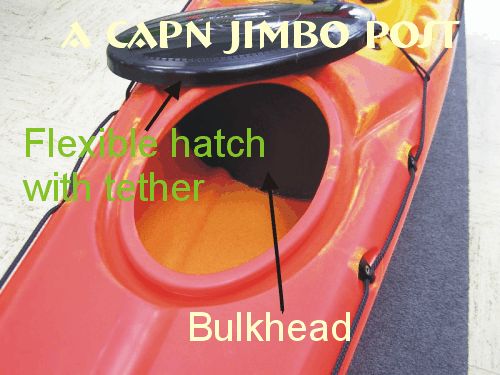
The Midway sports a nice large flexible tethered cover and roomy front hatch.
Note too that the hatch sports effective drain channels to keep things dry.
Lots of storage and surprise! A forward bulkhead. This is a first in its class.
Almost no one carries flotation, and all kayaks - especially Hobies - need it! Even if flooded or holed, the Midway is unlikely to sink.
But there's a downside too. You can't stuff your one piece rods down the sides. Personally, I'd rather carry adequate pool noodles,
and retain the access.
An added bonus is that the bulkhead helps support and stiffen the hull. Still, those
who demand full length access can breach it.

Before I get to the center baby carrier, look at those leg accommodating footwells. Heretofore,
the Scupper Pro had the longest footwells in the business at 47 inches. The Midway adds another two inches
to accommodate long legs. The footrests are RTM versions of the Ocean Kayak design and do exactly what is needed -
to give you solid support for power paddling and proper rotation. They also sport two positions for your heel at
each foot position. Most excellent!

Now here's something mysterious. Three molded in, female threaded inserts. I was unable to find out
what these are for, but anyone but a simian can easily figure out how to attach an accessory bar,
GPS, camera, rodholder or other creations of your own. Now to the cockpit.

Nice butt-shaped seat, not as deep as the Disco, but deep enough that a rotation inhibiting backrest is really not required.
And now for the "baby seat". This is actually an adjustable thigh brace (called the "Knee Tree"), a real innovation. I'll
cover this extremely useful device later. Note that it is bungied.
A good place to carry a water bottle, lure box or bunch of bananas. Vibrator optional, batteries extra.
The indented side lifts (like the Disco) are perfectly placed at the balance point, and
are superior to the carry handles for a suitcase carry. The handles are nice for transitioning to a shoulder carry.
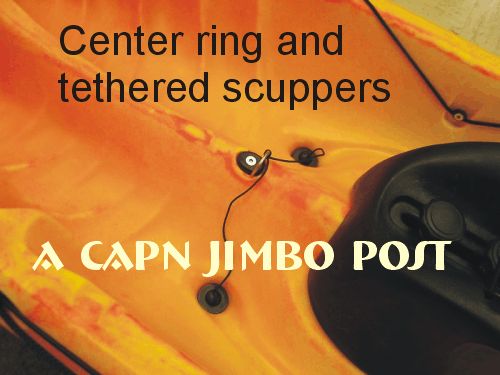
The tethered scuppers are easily reachable. Note also the drain channels leading forward from the seat.
Sensible and effective. At this point I am obligated to point out that the Midway is surrounded by
safety/grab lines with indented fittings which replace the usual, less effective cheap plastic inchworms.
Another nice touch: like the Disco, the Midway's cockpit is lightly pebble-grained. This promotes more
secure seating and hand gripping during reentry.
Do I have to say it? RTM is known for attention to quality and detail and the Midway is just another example.

Another detail is the molded in dive flag holder. It just gets better and better.
Compare this to the dangerous, reel destroying flush mounted rod holders that so many marketing driven companies
insist on providing.
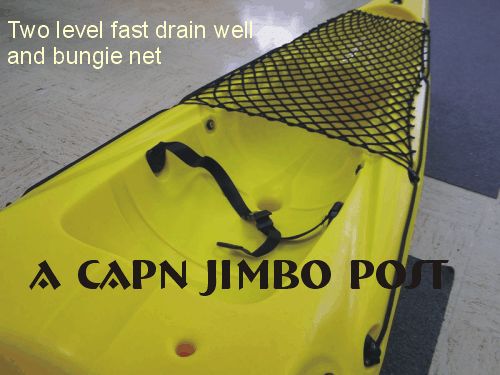
The Midway's tankwell, like the Disco, is a safe, two level, fast draining, designed
for diving and easily adaptible for fishing. The old Midway used to offer a custom fit
gear box to fit this space. The rear half has the RTM bungie net cover, quite
useful. But there's more detail that doesn't meet the eye...

Yup, like the forward bulkhead, yet another safety feature: molded in
paddle channels and bungie locks for your spare paddle. What's that, you don't carry one?
The Midway makes it possible and puts them within easy reach. Since the well is fast draining, the
single large drain should be more than sufficient to let the few remaining cupfuls of water.
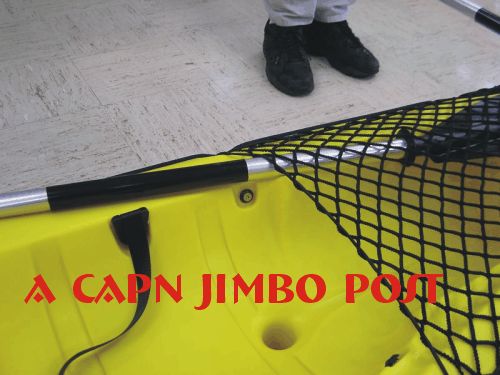
Here they are in action. Let's finish at the stern.

Here's a nice view of the stern. Unlike the Disco, the Midway is hard chined (there
are actually two chines). The hull is relatively flat with two hull-stiffening channels
that hide ordinary scuppers (unlike the Disco's venturi-like drains).
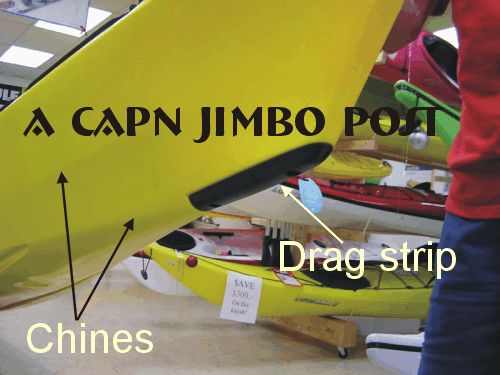
One last feature and yet another RTM innovation. A built in wear strip for
those times you just have to drag your yak over some tough stuff (shame on you).
How bout that!
In sum, the RTM Midway is a mature and thoughtful design. I knew two years ago - the first time
I saw this design and without a water test - that it was a winner. In fact,
I called it "the possibly perfect plastic fishing machine". Still, the
proof is in the saltwater, so flu and all, I hadda take it out.
Water Test and Review
First, my sincere thanks to Kayak Jeff of, uh, Kayak Jeff's on Dania Beach Blvd (shameless commercial plug) for his hospitality and for allowing me the great pleasure and opportunity for an extended test of the first Disco, and now the first Midway. I never really thought Midway would ever make it here, but am I glad they did. Vive la France!
Conditions? I launched at Jeff's convenient ramp up at the Pompano store. Jeff has the perfect setup: a wide canal
adjacent to his store. I signed my life away, and hit the water. Winds were about 15, gusting, with a light chop.
Weight? The Midway is an honest 60 lbs, stripped. I have always held that 55 is stretching it, but I should add that learning and using
proper a proper lift and shoulder carry makes a huge difference. Still, 60 poinds is pushing it for many kayakers.
Stability? The Midway's combination of hard chines and only slightly convex hull adds to its sense of stability. I'd call it moderate primary, with an easily found secondary edge. Intermediate paddlers will appreciate this.
Turning? My usual stationary turning test is designed to see just how far a kayak can be spun in a single sweep. For purposes of comparison,
the Necky Spike can easily be 180'd. The Pro is nearly is as good, usually about 160 degrees or better. The Disco requires better technique, but can be made to turn about 140 - 160 deg.
I was able to accomplish a relatively easy 130 - 140 with the Midway, and I suspect that with just a bit of water time, would come close to the Disco.
This is more than acceptable. Compare to Tarpon 140 which can barely make 90 degrees,
or the T-160 at a crummy 60.
Turning underway is another matter. This is where the baby seat - which RTM calls the "Knee Tree" - really comes into play. Unlike thigh straps, the "Knee Tree" can be adjusted foward and
back for a good fit. It is very comfortable and feels part of you. Accordingly, lean turning comes very naturally. Going over accidentally is not
really likely because the chine gives you a nice predictable edge to work to, and which provides a nice safety margin. I suspect that
the Midway can be leaned much further than I did on this first paddle, especially as I had the flu,
and was not particularly interested in capsizing in cold water. Even with just a modest
lean, the Midway carves a mean turn, and keeps on turning as long as you maintain the edge.
This is impressive. However, do keep in mind that the "Knee Tree" thigh brace is easily removed,
or can be moved forward.

Ouch. But it's not hard to imagine creating making a nice center platform
that can be mounted using the three molded in female threaded fasteners.
Tracking? Like the Disco, great. You won't need a rudder with the Midway. Enough said.
Speed? Keep in mind that I've been spending considerable amounts of time in the Disco. The first thing I noticed
was that the Midway is not quite as agile. Nor does it accelerate quite as readily. Nor is it quite as quiet. But it is very close, and
the Midway has a very solid and comfortable feel, excellent glide. Get it going and it will keep going - like an aircraft carrier at the turning point Battle of Midway -
you should maintain a nice fast cruise with not much effort. Very nice.
The USS Midway was commissioned in memoriam at the end of WWII. Actually, the original (Dag) name for this lovely
design is the "Mid-Way" - referring to a design "halfway" between an SOT and a SIK sea kayak.
Some may wonder why the Disco is a (slightly) faster kayak. Quite simply, the Midway is a noticeably fuller design, and has a relatively
flatter hull. The Disco narrows quickly and is based on a true, moderate vee hull. Without running the numbers,
I am confident the Midway has a significantly greater wetted surface. Another factor is the
Midway's lack of the Disco's rocker and overhang. Although in ideal, flat conditions the Midway could be
pushed faster, it has been my long experience that most kayaking is in far from ideal conditions.
What the slightly shorter Disco lacks in waterline length, it more than makes up with its
easy, narrow entry and agility. Thus, overall the Disco is faster, and will catch
more wakes and waves, easier.
But don't get me wrong. The Midway is an excellent performer, and should blow away most
all other plastics, and give the Dorados, Pelicans and Marlins a run for their money.
Seaworthy? Yes. This kayak should do well in any conditions and has all the important safety features. Full lifelines,
floatation, fast drain well, and a reliable, true sea kayak design. Although there were no wakes or real waves
to surf, I have little doubt that the Midway, like my Disco, will surf well. It is a sad thing
that most plastic monkeys will never really experience the extended surfing that kayaks like the Disco
and Midway can provide. Being able to catch and keep wakes and waves is not only fun, but should
be your usual practice as this can add a lot of additional, easy miles and extra speed.
Such is life.
Conclusions
The Midway, like the Disco can fairly be described as a midsized sea kayak and resembles RTM's long fiberglass sea touring kayaks. Its design is thoughtful, incorporates every conceivable safety feature, and is far superior to almost all ordinary plastic SOTS. It is well thought out in almost every regard and handles well, if not absolutely quietly. It is fast and has good glide. It is well constructed, with quality fittings.
The Midway carried my 185 pounds easily. The seat is roomy and the Midway should be great for all but the biggest boys. Unlike OJ, if you can fit, you need not acquit, buy it!
Bottom line:
RTM makes the three best plastics on the water today: the Tempo, the Disco and
now the Midway. The Midway is a very serious, high performance fishing machine, second
only to the Disco. It will accomodate the heavier paddler (over 200 lbs), and has
the extra volume to carry plenty of extra weight. It will get you where you're going in
complete safety, in any conditions.
Is it a Superyak? No. But it will give Dorado owners fits.
My only reservations: the Midway I tested was an honest 60 lb., and its $899 price tag (especially when the Disco goes
for $599-650). Still, when you consider the Midway will be competing against the
Dorado, this represents a considerable savings. And the larger paddlers may need its additional volume.
Things I did not test: I failed to test the Midway with the scupper plugs out. Sadly,
I was unable to find any real wakes or waves to surf. I didn't push the test to find the capsize
point. I forgot my GPS. All of these will be rectified soon.
And to the KFS monkeys who follow my every word, chatter and spit, but then
end up by following my recommendations...
Havabanana!
Hope ya enjoyed this page! For more incredibly satisfying info...
Ft Lauderdale Yakfishing Club
Capn Jimbo's Forum in Paradise
Contact Capn Jimbo, Chief Yakker
|

